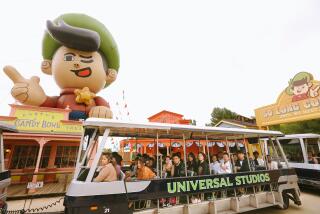Magic Mountain riders rescued after Ninja roller coaster derails
About two dozen people were trapped for nearly three hours on the Ninja roller coaster at Magic Mountain and four others were injured after a tree branch obstructed the high-speed ride, officials said.
The ride was in a “precarious position” as the people were suspended about 40 feet above the ground on the roller coaster, said Michael Pittman, a Los Angeles County Fire Department dispatch supervisor.
He told The Times that the four injuries appeared to be minor.
The 22 people on the ride were safely evacuated around 8:30 p.m., Magic Mountain spokeswoman Sue Carpenter said. She said two of the riders were “transported to a local hospital for precautionary measures.”
A tree branch somehow obstructed the roller coaster, stranding several cars and forcing the ride to be shut down shorlty before 6 p.m., officials said.
Fire Inspector Fred Flores said the branch was lying across the tracks, derailing the first car. He said that 11 people had been rescued and that 11 more were waiting to be removed from the cars as firefighters worked amid the branches above the ground.
“It’s in a very difficult place to get to,” Flores told KCAL-Channel 9.
The people on the ride were “all alert and corresponding with park personnel during the evacuation process,” Carpenter said in a statement.
A specialized urban search-and-rescue team, which has extrication and clamping tools, was dispatched to the park. Firefighters positioned ladders next to the roller coaster, which was amid thick foliage, according to television news footage
Stranded passengers could be seen talking to firefighters who were next to the car working to free them.
Magic Mountain bills the Ninja ride as “The Black Belt of Roller Coasters,” racing along a twisting track at 55 mph.
“Your whole body will swing out to the sides as you take winding snake-like turns at nearly 4G,” the park says on its website.
The ride will remain closed while inspectors survey the track and the area, Carpenter said.
“The safety of our guests and employees is our No. 1 priority,” she said.
Earlier this year, a Times analysis of more than 2,000 accident reports from Southern California theme parks found that accidents were rare.
The most common accidents and incidents were fainting, nausea and dizziness. People were more likely to get sick or hurt on older attractions than on newer rides. And about 1 in 8 accident reports, as they are called, involved riders who were hurt while getting on or off an attraction.
The analysis examined 2,089 injury reports filed from 2007 through 2012 with the state Department of Industrial Relations, which oversees the safety of theme park rides.
Follow @LAJourno for breaking news
More to Read
Start your day right
Sign up for Essential California for news, features and recommendations from the L.A. Times and beyond in your inbox six days a week.
You may occasionally receive promotional content from the Los Angeles Times.






